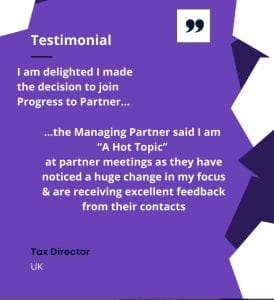Working in Big 4 or Mid Tier Firms – what are the differences?
Working for one of the Big 4 – KPMG, EY, Deloitte, or PwC – is often seen as the best career for accountancy and consultancy professionals. It’s certainly great for the CV, but how different is the experience from working in a Mid Tier firm? With many Big 4 firms deciding to trim their partner numbers and make selective redundancies, many of us will be considering our options career wise. Should we stay at our Big 4 firm? Or should be ‘trade down’ to a mid-tier firm. In this blog post, I explore the 7 main differences between a Big 4 and Mid Tier Firm.
If watching rather than reading is your thing, in this video (12 mins) I talk in detail about the key differences between the Big 4 firms and the Mid-Tier firms. (For more videos to help you progress your career in partnership, subscribe to my channel on YouTube: How to make partner and still have a life)
What are the Mid Tier Firms?
The Mid-Tier firms are traditionally seen as any firm which is a not a Big 4 firm (Deloitte, EY, KPMG or PwC) or not a regional, strong high street firm or small firm. As a rule of thumb, think of the Mid-Tier firms as the top 100 UK firms, minus the top 4 firms. Over the last 5 years the top of the Mid-Tier, BDO and GT have made some strategic acquisitions and have put a gap – definitely in the UK – between themselves and the rest of the Mid Tier. However, the smallest of the Big 4 firms in the UK is still bigger in size than if firms 5 to 100 on the UK top 100 accountancy firms list were put together as one firm.
Take a step forward to be in control of your own career progression in your firm. Sign up to my weekly tips here and you’ll find out what you need to be working on in your career development (and how to make the time for your career development) to progress your career in your firm
Big 4 firms – a broader range of specialisms and larger clients
Whilst recent audit reforms mean that more Mid Tier firms get to audit FTSE 100 and FTSE 350 companies than before, it is fair to say that the Big 4 – EY, KPMG, Deloitte, and PwC, tend to work on clients at the top of the Mid Market through to the largest multinational and international firms. If you work for a Big 4 firm you can normally guarantee to work with the largest companies and richest private individuals. With the advent of cloud accounting tools for small businesses, i.e. Xero and Quickbooks, many of the Big 4 firms, as well as GT and BDO, in the UK introduced a service for small businesses. However, most of the top 6 firms are now dismantling their small business arms, and have gone back to their main focus, i.e. large international and national businesses.
After the Sarbanes-Oxley Act in 2002, the Big 4 firms sold their large consultancy arms. Over the last ten years or so, they have been rebuilding their consultancy practices by diversifying their offer, whilst retaining their traditional accountancy, tax and advisory services. After all, given the unprecedented access most of the Big 4 firms have to large businesses in the UK and globally, it makes sense to be able to offer a complementary consultancy service. It’s probably unfair now to call the Big 4 firms an accountancy firm. They are all now multi-disciplinary consultancy firms offering their clients audit, tax, legal, consulting, M&A, insolvency and accounting services. With the current changes being announced to the audit independence rules in the UK, the Big 4 are being required to separate their audit business from the rest of their business. Although the regulator stopped short of requiring the Big 4 firms to make their audit businesses a separate legal entity to the rest of their practice.
The Mid Tier firms, and not just the ones at the top, do offer services outside the traditional accountancy, tax, and advice. However the Mid Tier consultancy practices are often tiny in comparison to those in the Big 4 firms.
Whilst you can become a highly technical specialist outside of the Big 4, there is more opportunity to specialise in a Big 4 firm.
Working for the Big 4 means a big salary
 When I worked for BDO, a top 5 UK Accountancy practice, it was widely accepted that they could never compete with the salaries and packages offered by the Big 4 firms. If you are lucky enough to get a role in a Big 4 firm you can expect a ‘market-leading’ salary and benefits. Of course, you will be expected to work extremely hard to earn this. Read my post about what it really means to make partner. With the post-COVID-19 world starting to become more apparent, expect to see the Big 4 start to rely more on resources which are located outside of London and the major commercial centres around the world. I.e. because of lower salary costs and also their staff wanting to work more from home and outside of the large city centres.
When I worked for BDO, a top 5 UK Accountancy practice, it was widely accepted that they could never compete with the salaries and packages offered by the Big 4 firms. If you are lucky enough to get a role in a Big 4 firm you can expect a ‘market-leading’ salary and benefits. Of course, you will be expected to work extremely hard to earn this. Read my post about what it really means to make partner. With the post-COVID-19 world starting to become more apparent, expect to see the Big 4 start to rely more on resources which are located outside of London and the major commercial centres around the world. I.e. because of lower salary costs and also their staff wanting to work more from home and outside of the large city centres.
“I know if I had stayed at EY and made it to partner, I would have been a very rich man
Ex-EY Director
A Big 4 firm feels more corporate
Whilst the Big 4 are still Limited Liability Partnerships, they are much closer to a corporate than any of the Mid Tier firms, including those at the top of the Mid Tier – BDO, Grant Thornton (GT), or Baker Tilly. This means there are generally more established processes and systems within Big 4 firms than in the Mid Tier. In fact, some of the firms in the UK Mid Tier are currently spending huge amounts of time introducing a consistent way of working. For example, the Partnership Admissions Process for Mazars and BDO feels very similar to the Partnership Admissions Process of the Big 4 Firms.
Take a step forward to be in control of your own career progression in your firm. Sign up to my weekly tips here and you’ll find out what you need to be working on in your career development (and how to make the time for your career development) to progress your career in your firm
The Big 4 can admit more partners every year
Given the relative size differences between a Big 4 firm and a Mid Tier firm, it is not surprising that there are more partners admitted every year within the Big 4. According to the 2019 Accountancy Age Top 50 table, the Big 4 have 3309 partners between them. This is more than all the partners in the top 50 to top 5 UK firms. This means that the Big 4 have a little more wiggle room to admit a new partner and then help them build their client portfolio. However, given the contraction in the global economies of the world due to the COVID-19 triggered recession, the Big 4 firms are in 2020 and 2021 reducing their partner headcount. Either via early retirement or forced exits for the lower performing partners or partners in areas which have seen a massive decline in revenues.
Much longer working hours in the Big 4
 The higher salaries offered by a Big 4 firm almost always translate into a longer working week for fee earners than if they worked in a Mid Tier Firm. When I worked for BDO, the partners there had often proactively chosen to work at BDO for a better quality of life. After all, money isn’t the be all and end all. My post about the pros and cons of making partner will give you food for thought here.
The higher salaries offered by a Big 4 firm almost always translate into a longer working week for fee earners than if they worked in a Mid Tier Firm. When I worked for BDO, the partners there had often proactively chosen to work at BDO for a better quality of life. After all, money isn’t the be all and end all. My post about the pros and cons of making partner will give you food for thought here.
Big 4 can offer greater mobility and larger international networks
The international networks are very important to all the top firms in the UK. However, it is fair to say that the Big 4’s international networks’ individual member firms tend to be closer than the individual members of the Mid Tier networks. With this increased closeness, Big 4 fee earners are expected to be more geographically mobile than fee earners in the Mid Tier. This expectation of mobility for the Big 4 firms could mean high flyers are expected to take a secondment abroad, or relocate their family to take advantage of a partner role in another office. In fact I was recently advising a Director in Deloitte in Canada on whether he should move his family over 1000 miles for better partnership prospects.
Higher ‘gearing’ of staff to partner in the Big 4
The partners in the Big 4 firms earn substantially more profits per partner than partners in the Mid Tier firms because they have a higher gearing. This means there is perhaps 10-20 members of staff to 1 partner in a Big 4 firm, rather than 5-10 members of staff to 1 partner in a Mid Tier firm. This is part of the reason why many Mid Tier firms actively differentiate their firm’s services as ‘partner-led’ – that is to say that a client is more likely to be dealing directly with a partner rather than with a manager or director.
The Big 4’s higher gearing means that although there are many more Big 4 partners made up in any one year than in a Mid Tier firm, there is also much greater competition for partner opportunities.
Take a step forward to be in control of your own career progression in your firm. Sign up to my weekly tips here and you’ll find out what you need to be working on in your career development (and how to make the time for your career development) to progress your career in your firm.
It’s a case of horses for courses. Big 4 firms are likely to offer more opportunities, challenges, and benefits than most Mid Tier firms, but these come at a cost of longer hours, greater competition, and some personal sacrifice.
 We created the Progress to Partner Academy to make building your partner-ready skills and getting noticed for partner-track as easy as possible. There are guides, self-study courses, useful videos, workbooks waiting for you – everything you need to know about how to make partner all in one place! There’s even a course on “how to make the time for business development”.
We created the Progress to Partner Academy to make building your partner-ready skills and getting noticed for partner-track as easy as possible. There are guides, self-study courses, useful videos, workbooks waiting for you – everything you need to know about how to make partner all in one place! There’s even a course on “how to make the time for business development”.








